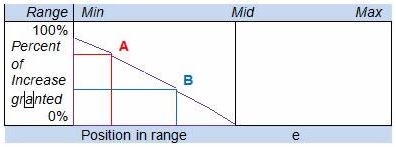Barry L. Brown, SPHR, CCP, of Effective Resources, Inc., understands that time and budgets are both at a premium—but that your compensation plan is probably still in need of some TLC. Yesterday, we got some of Brown’s tips for a DIY compensation makeover. Today, his thoughts on remedying a common but serious comp problem: wage compression.
 |
What Causes Wage Compression?
Wage compression is self-induced at virtually every company, Brown says. It’s often created when ranges change and is usually created when a new person is hired and paid more than the incumbent(s). Unfortunately, it’s a problem that cannot be hidden or explained away and, if unsolved, will likely result in expensive legal action. The only way to solve it, Brown says, is with money.
Of course, your compensation philosophy will dictate what you do, to some extent. The important question to ask is, How long for someone to get from the minimum to the midpoint? That’s another way of saying, How long does it take for someone to be fully productive?—because those people should be at the midpoint. It shouldn’t take more than about 3 years for most jobs, Brown says.
Compensation.BLR.com, now thoroughly revved with easier navigation and more complete compensation information, will tell you what’s being paid right in your state–or even metropolitan area–for hundreds of jobs. Try it at no cost and get a complimentary special report. Read More.
Look to the Ranges
An important part of avoiding compression is dealing with changes in the ranges. Brown offers his “triangle” approach for dealing with people below the midpoint when ranges increase.
How to determine how much of the general increase to give to employees below the midpoint?
First of all, people at or above the midpoint needn’t get part of the range increase—they are already being paid market for their jobs. And people below the minimum should move to the minimum—that’s just common sense.
For those in the range but below the midpoint, create a sliding scale triangle as shown below. It starts at 100 percent of the range increase for those at the minimum and tapers down to 0 percent for those at the midpoint.
The concept is that the people farthest below the midpoint get the largest bump. Find the person’s position in the range on the bottom line, then draw a line up to the slanted line, and read across to find the percentage of the range increase. For example, A is low in the range and will receive 80 percent of the increase. B is not so low in the range and will receive 40 percent of the increase.

Note that this is all independent of merit or other types of increases; this is just staying with the market.
Wage compression, compensation makeovers, base pay, variable pay, incentives, increases … compensation and benefits are never easy! “Maintain internal equity and external competitiveness, with benefits and compensation, and control turnover, but still meet management’s demands for lowered costs.” Sound familiar?
Many of the professionals we serve find helpful answers to all their compensation and benefits questions at Compensation.BLR.com®, BLR’s comprehensive compensation website.
And there’s great news! The site has just been revamped in two important ways. First, compliance focus information has been updated to include the latest on the Consolidated Omnibus Budget Reconciliation Act (COBRA), Lilly Ledbetter, and the Family and Medical Leave Act (FMLA). Second, user features are enhanced to make the site even quicker to respond to your particular needs, such as:
- Topics Navigator—Lets you drill down by topical areas to get to the right data quickly
- Customizable Home Page—Can be configured to display whatever content you want to see most often
- Menu Navigation—Displays all the main content areas and tools that you need in a simple, easy format
- Quick Links—Enables you to quickly navigate to all the new and updated content areas
The services provided by this unique tool include:
- Localized salary finder. Based on reliable research among thousands of employers, there are pay scales (including 25th, 50th, 75th, and 90th percentiles) for hundreds of commonly held jobs, from line worker to president of the company. The data are customized for your state and metro area, your industry, and your company size, so you can base your salaries on what’s offered in your specific market, not nationally.
Try BLR’s all-in-one compensation website, Compensation.BLR.com®, and get a complimentary special report, Top 100 FLSA Overtime Q&As, no matter what you decide. Find out more.
- State and federal wage-hour and other legal advice. Plain-English explanations of wage-hour and other compensation- and benefits-related laws at both federal and state levels. “State” means the laws of your state because the site is customized to your use. (Other states can be added at a modest extra charge.)
- Job descriptions. The website provides them by the hundreds, already written, legally reviewed, and compliant with the Americans with Disabilities Act (ADA) mandate that essential job functions be separated from those less critical. All descriptions carry employment grade levels to current norms—another huge time-saver.
- Merit increase, salary, and benefits surveys. The service includes the results of three surveys per year. Results for exempt and nonexempt employees are reported separately.
- Daily updates. Comp and benefits news updated daily (as is the whole site).
- “Ask the Experts” service. E-mail a question to our editors and get a personalized response within 3 business days.
If we sound as if we’re excited about the program, it’s because we are. For about $3 a working day, the help it offers to those with compensation responsibilities is enormous.
This one’s definitely worth a look, which you can get by clicking the link below.
Click here to get more information or start a no-cost trial and get a complimentary special report!
